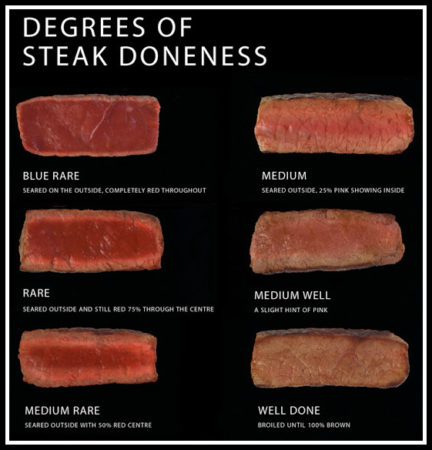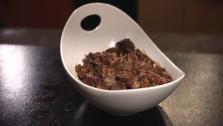Planning a steak dinner soon? Here are a few quick tips.
The Ultimate Guide to Steak – From Preparation to Your Plate
By Marcio Benedetti
Steak QualityThere is nothing better than sitting down to a dinner that includes a perfectly grilled steak. Unfortunately, learning the art of grilling a perfect steak may take years. One of the most common mistakes many home cooks make in their journey to a perfect steak is to try and disguise a low-quality piece of meat with massive amounts of marinade. A steak drowning in marinade, along with improper cooking, typically leads to an inedible steak. If you have ever pondered the thought of what it takes to grill the perfect steak, this guide is the solution. From choosing the best quality steak to fail-proof cooking techniques, this guide is designed to help you learn everything you need to know to prepare and grill the perfect steak.
The most important factor in creating an amazing steak is the quality of the meat. It doesn’t matter how well you have perfected your cooking technique or how expensive the marinade was; you cannot mask the flavor of a low-quality steak. When you use quality meat, there won’t be a need for marinade; in fact the only time you should marinade is if your finances won’t allow you to buy quality meat.
Grading, which is done by either a government agency or another 3rd party organization, also helps determine the overall flavor of the meat. The grade of a steak is basically determined by the marbling of fat in the meat and the age of the animal, but the color, firmness and texture also play a role in determining the grade. There are 3 grades for steak:
- Prime: This is the highest quality of beef. The majority of prime beef is exported, making it difficult to get, so it is usually sold to quality steakhouses. Prime contains the greatest amount of fat marbling and is usually derived from younger animals.
- Choice is the second highest quality of beef and it is usually the highest quality meat you can find in the grocery. Choice has less marbling than prime and it is typically the highest recommended grade.
- Select is the lowest quality of meat. It has significantly less marbling than prime or choice, which also creates less flavor as well as a tough texture. This is the grade of meat that typically requires marinade and/or tenderizing before being cooked.
Along with the grading of meat, other factors, such as how and where the meat is raised have an impact on the quality. It is important to keep in mind that the only true grade for meats is listed in the USDA shield found on the packaging.
Steak Cut
The cut of a steak is just as important as the steak quality. Although there are several different cuts of steak, the following are the most flavorful types of steak that can be quickly cooked with dry heat:
- Ribeye is often considered to be the best cut. Ribeye has the highest fat content and marbling, resulting in a juicy steak with excellent flavor.
- New York strip, which is also known as Kansas City cut, is an extremely tender cut of meat, even if you like it on the rare side.
- T-bone steaks are another great cut and are appropriately named due to the “T” shaped bone in the middle of the steak. T-bone steaks have meat from two separate cuts, on opposite sides of the bone; a tenderloin on one side and a New York strip on the other side. These steaks are generally expensive because they have two of the best cuts of meat and they are usually larger than other cuts.
- Tenderloin, also known as filet mignon, which are thought to be the most tender type of steak as well as the most expensive cut.
- Sirloin is the most common type of steak, especially for grilling because it is reasonably priced and widely available. There are a number of sirloin sub-categories, which typically affect the price, but not the quality.
Preparing and Cooking
When it comes to steak, the cooking method is frequently debated. It is not uncommon for arguments to occur when it comes to the topic of how to “flavor” a steak, but it is important to keep in mind that the marinade, spices and seasonings you choose are your personal preference. Preparing a steak typically includes:
- Salt and pepper – almost everyone agrees that salt and pepper are a must for a good steak. But when they should be used is often questioned. Some prefer salt soaks, while others argue that pre-salting will dry the meat out. Pepper, is actually a personal preference, as well as how much is used, what type of pepper is used and when it is added during the cooking process.
- Oil or fat is not usually necessary for a steak, but it may add a unique flavor that you personally enjoy. It is important to use caution when cooking a steak that has been coated with oil. For example, regular olive oil will add flavor without burning the steak, while extra virgin olive oil will provide more flavor. However, extra virgin olive oil will often cause the steak to burn quicker and dry out. Butter is often recommended because it adds flavor and does not burn as quickly as extra virgin olive oil.
- Marinades are the most heated subject when it comes to steaks. Marinades should not be used on a high quality steak because they are meant to be a way to disguise and enhance the taste of a lower quality cut. Marinade is designed to complement or enhance the flavor of a steak, not overtake the meat.
A steakhouse typically broils steaks and only sears them just before serving. Cooking at home, however, requires different forms of heat, so the steak is typically seared throughout the whole time it is being cooked. Grilling and broiling are both forms of dry cooking, so home grilling can produce the same effect as steakhouse broiling if done correctly. Regardless of how the steak is cooked, the most important factor for a great steak is to let it sit to room temperature before cooking. Methods to cook a steak at home may include:
- Grilling – Gives the steak a great smokey flavor and can be customized by using various types of wood, such as maple, cherry or cedar. When cooking with charcoal, it is best to avoid using lighter fluid, which can affect the flavor of the steak. The meat should be placed over embers as opposed to an open flame, which can cause the meat to cook unevenly.
- Skillets – Great for cooking a steak, especially when you use the steak’s own fat or butter for cooking. It is essential that you use a skillet large enough to prevent the steak from touching the sides of the skillet and cook over medium to medium-high heat.
- Broiling – The most recommended method for cooking a steak because it allows the meat to cook evenly. Make sure you preheat the broiler and that the oven rack is about 4-inches away from the heating element. Broiling a steak typically takes 2 to 20 minutes, depending on your preferred wellness.
Wellness
There is no right or wrong when it comes to wellness; it is really your personal preference. A steak that is less well done is typically juicier and has more flavor, however, a lower-quality of meat typically must be cooked longer for it to be tender and safe to eat. Although the most accurate way to determine the wellness of a steak is with a thermometer, you can also test wellness by touch. A rare steak feels more “springy” than a well done steak, so the more firm the steak feels, the greater the wellness. The temperature and color can also help determine the wellness:
- A blue rare steak is 99% red in the center, with only the outside being seared for about one to two minutes on each side. The temperature of a blue rare steak is 70-100 degrees Fahrenheit.
- A rare steak has a center that is about 80% red, but seared on the outside (2-3 minutes each side) and the temperature is 100-102 degrees Fahrenheit.
- A medium rare steak has a center that is about 50% red and is seared for 3-4 minutes each side. The temperature of a medium rare steak is 125-145 degrees Fahrenheit.
- A medium steak is seared for about 4 minutes on each side and is pink in the middle. The temperature of a medium steak is 146 to 155 degrees Fahrenheit.
- Medium well steaks are cooked throughout with a center that is barely pink. Medium well steaks are typically cooked for about 6 minutes on each side and have a temperature of 156-170 degrees Fahrenheit.
- Well done steaks are completely cooked throughout, there is no pink and the center is 100% brown with a temperature of 170 + degrees Fahrenheit. Well done steaks are typically cooked for about 7 minutes on each side.

Image Credit – https://steakandco.wordpress.com/2012/11/15/doneness-level-your-steak-depends-on-it/
After cooking a steak it is best to allow the meat to rest for about 5 to 10 minutes before piercing, which will help the meat retain its delicious juices. It is also important to note that even after removing the meat from the heat, the temperature may continue to rise by as much as 10 degrees. Keep this added temperature in mind while cooking the steak to avoid over-cooking.
While this guide provides the guidelines necessary for preparing and cooking a great steak, it is important to keep in mind that perfection takes practice. Experiment with various cuts and cooking methods until you find the best method to suit your individual preferences and palate.
About the Author
Marcio Benedetti is an avid foodie/home cook and also runs iQ Cleaning, a Washington DC-based maid and house cleaning company. When he’s not at the office or out in the field helping his team, he enjoys writing about cooking, thinking about cooking, and of course, cooking. He also enjoys spending time with his family, reading, and enjoying the outdoors.
Category: Various Cooking Styles









